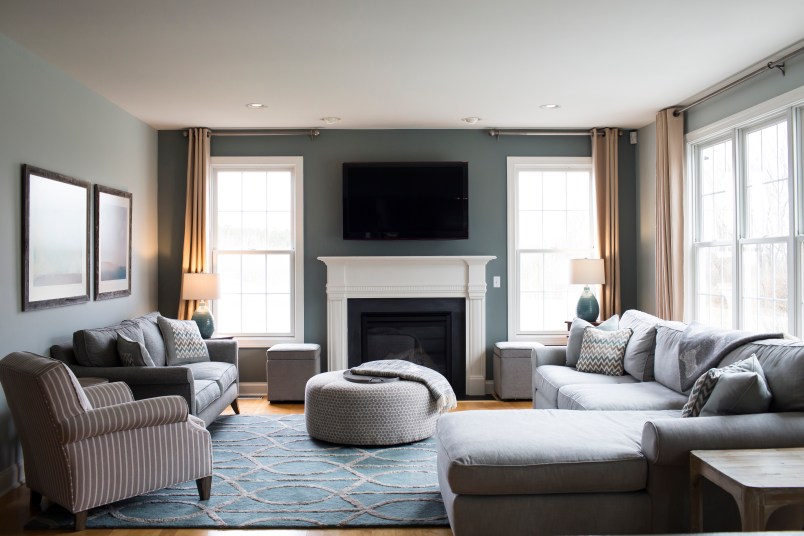5 Interior Design Elements to Consider That Will Instantly Elevate Your Home

Designing and filling your home’s interior can be a complete minefield. There are way too many choices out there, and it’s never the right time to start renovating. That said, there are a few steps you can take to ensure your spaces are considered, balanced, and pack plenty of punch. Scroll down to discover the five factors interior designer Shannon Vos considers when creating a cohesive room.
1. Space
Arguably the most important consideration in designing a room is how the space works. It must cater to the needs of the people using the room without feeling cramped. So, don’t forget to take into account the negative space in a room — that’s the space not being used. If you have, for instance, giant vaulted ceilings, you can utilize this normally unreachable space with larger-than-life pendants, oversized fans, or even a visual element such as shiplap cladding so the room doesn’t feel like an airport waiting area.
It’s also important to leave enough space between elements so people can comfortably move through the room, but not so much that you’re running a half-marathon during the day. Generally, four feet is enough between significant furniture pieces and zones, but if you have the luxury, a five-foot buffer can be ideal.
Keep your furniture off the walls just a touch to prevent any damage, but also to give the illusion of space. Even in a smaller room, a sofa placed just off the wall will make the room look bigger than it is.
It’s all about balance. Balance the negative with the usable space and your room will feel coherent and resolved.
2. Light
A good lighting plan is often overlooked during a renovation or build, but it can make or break a space. Your floor plan will usually determine your lighting plan — and if you have it, natural light is always best. Just remember, it constantly changes throughout the day and will change the way colors look. Morning light from the east is usually cool, compared to afternoon light from the west, which is warmer in color.
Aside from this, you’ll require a good mix of ambient, accent, and task lighting to create depth and character in your rooms. Too many canister lights can kill a vibe in any home, so don’t overdo it. Instead, floor lamps, table lights, wall lights, ceiling lights and recessed wash lighting can come together to light up what you need and where, as well as creating mood and ambience.
Always use warm light in your home and try to light up interesting features in a space. It might be timber floors, a vaulted ceiling, or a prized artwork. Anything that can deliver character and interest in a space will be miles ahead of the all-too-often-chosen gazillion canister lights.
3. Color
We all know how warm and cool colors can change a space and the people in it — but how do we come up with a color palette that suits the natural light and the style we’re going for, and that will still look good 10 years from now?
It all starts with the sunlight you’ve been afforded, as natural light will amplify the brightness of any colors you decide on. A white room will look dazzling bathed in sunlight — but without it, it can feel drab. Therefore, it’s always best to test your color palette in your spaces before committing to painting a whole home.
I tend to work on the 60/30/10 rule. This is where 60 percent of a color used is the main color, and acts as an anchor and a backdrop for the rest of the space. Thirty percent of the space could be a secondary color — this tone needs to work harmoniously with your main color, but also be different enough to have its own identity. Lastly, you will want a 10 percent accent color, which can be a pop of anything that grabs the attention and makes a statement.
These colors don’t necessarily need to be paint-based. Anything in the home can make up these figures — timber floors, vibrant artworks, bright throws, or even a sofa. They will all build a palette.
Color combinations usually come in monochromatic, complementary, triadic (a group of three), or analogous schemes. They all work to create different character in a space, so do plenty of research before deciding on a color scheme.
I tend to choose a base color first, then identify what color scheme I’m after, and the rest seems to work itself out. Color is a very personal thing, so don’t commit to anything you haven’t fallen in love with.
4. Texture
Texture is paramount in any space. A heap of shiny, glossy surfaces means your living room will quickly start to look like a dental surgery. On the other hand, you probably don’t want your space to feel like a carpet shop in a Turkish souk, either.
As with light and color, it’s all about balance and diversity. Balance the fluffy throws with matte stone surfaces, plush pillows with oak timber grain, and soft tassels with shiny brass frames.
5. Shape and Pattern
Having balance in your shapes brings elements together. You wouldn’t fit a round rug under a rectangular dining table, for instance — it just wouldn’t sit right.
The same can also go for your decor. A balance of round, square, and triangle shapes generates interest, but grouping like-shaped objects can make a scene feel cohesive and settled. It’s a similar story with pattern. Whether it’s a paisley throw or a chevron rug, it all needs to be balanced.
The best way to achieve all of this is by trial and error — either on paper or a screen, or, best of all, physically trying the elements together in the room. As the old saying goes, practice makes perfect!
This article was originally written by Shannon Vos. For more, check out our sister site, Homes to Love.
More From FIRST
15 Ways to Use a Lint Roller on More Than Just Clothes
9 Hair Dryer Hacks You Can Use All Around the House
Sprinkle Baby Powder on Your Hardwood to Shush a Squeaky Floor













